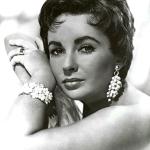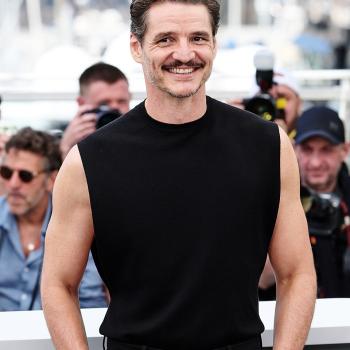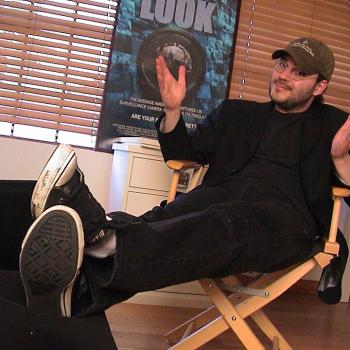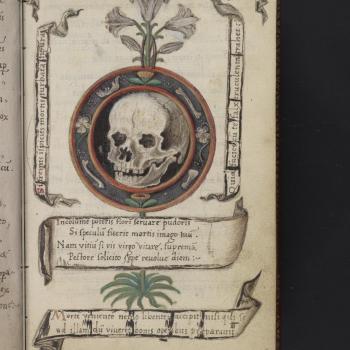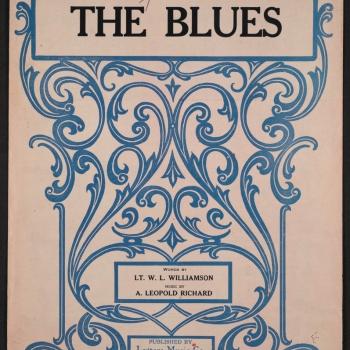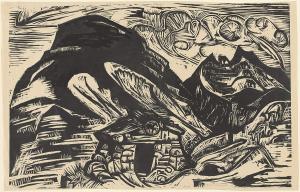
This may as well be Claire’s life; it’s certainly how she feels.
Source: Wikimedia
It might be Sweeney Todd’s (2007) fault. When I hear about a barber-serial killer, I assume humor, or at least campiness. It just lends itself to black comedy, or at least hokey jeering. Defenseless victims in the perfect spot to have their throats slit, snake oil salesmen and Dickensian orphaned errand boys, dancing—as if in love—around human-flesh-filled meat pies. The darkest things occasion laughter because, well, what else are we supposed to do? The Stylist (2020) doesn’t go for laughs. It made me want to jump out of my skin and out the window. But its photographic strategy is baffling at times. Still, it’s a fun one, worth your time, especially if you love feeling like you’ve got the chicken pox for 90+ minutes.
The movie, directed by Jill Gevargizian, concerns Claire (Najarra Townsend), a hair stylist in Kansas City, Missouri who, we learn almost immediately, uses late-in-the-day appointments as an opportunity to drug, scalp, and kill her victims. Her first kill hints at her extreme social anxiety. She seems troubled even as the woman in the chair boasts that she’s cheating on her husband—something now only the “boy toy” and Claire know. She never seems to know what to say, a stranger to the world of human language, though hardly a problem in a job where listening counts for way more than talking.
Narratively, the throughline is Olivia (Brea Grant), a client of Claire’s, asking her to fill in at the last minute as her wedding hair stylist. Claire, shaken by her recent killing, defers at first, but eventually comes around. Olivia is so grateful that she invites Claire over for pizza and wine, and even has her come along to her bachelorette party. Claire, we begin to see, is not just socially anxious she’s obsessive. The small kindnesses shown her by Olivia, the fact that both of their fathers died when they were young, their ability to (if awkwardly) “girl talk,” convinces Claire that they’re soulmates.
For her part, Claire continues murdering. It becomes clear, for example, when she follows home one of Olivia’s bridesmaids who insulted her at the bachelorette party, that she kills out of a desperate sense of inadequacy, failure, and rage. Her self-consciousness [think the scene in Boogie Nights (2007) in which Philip Seymour Hoffman screams “stupid” and bangs his head against his steering wheel after coming on to Mark Wahlberg). It’s a terrible cycle, one seemingly common now more than ever—a person feels disconnected from the world, so they fear to speak up or befriend people, suspect everyone dislikes them, and then, by seeming so standoffish or awkward, end up fulfilling their own prophecy. Claire, however, can restrain herself. She doesn’t murder the bridesmaid, seemingly for Olivia’s sake. The movie works in large part because we don’t know exactly what Claire is capable of. Sometimes she kills people who are nice to her (like a local barista); other times, she runs away before murdering a woman who insulted her. She dons the scalped hairdos in a mirror in her basement. Then, at one point, she padlocks the basement, seeming to swear off killing. The Stylist keeps us guessing, and thus unsure of ourselves, ready to leap off the couch.
Take, for example, a scene late in the film. Claire feels Olivia is being distant and so she keeps pestering her, asking if she can help with the wedding. Olivia assures her it’s fine, but Claire keeps sinking lower and lower until she surprises her “friend” late at night in her work’s parking garage (“how did you know where I worked?” asks Olivia. “You told me! I remember when you got the job. You were so happy!” responds Claire. The hair stylist is, we see, both the intimate confidant and the total stranger, a blank slate). Earlier on, Olivia’s had confided that she loved her fiancé, but that she didn’t always feel seen by him, a fact underlined when he interrupts her during a brief meeting with Claire. Claire, not understanding the context of normal human conversation, confronts Olivia with this fact during this (timid, but suspenseful) confrontation. The “soulmate” blows her lid: “I wouldn’t even let my mother say that to me a couple days before my wedding!”
At this point, we don’t know what Claire will do. Is she going to kill Olivia? Kill the fiancé? Kill the bridesmaid? Kill all the bridesmaids? Brood and ruin the wedding? None of the above. She slinks off and then, the night before the ceremony, sneaks into Olivia’s house. At first, we fear she’s got murder on the mind. That’s bad enough. But phew, no one seems to be home. She’s just creeping around—not so bad. Weird, but nothing too off-putting (for Claire anyway). But then she gets to Olivia’s bedroom, where she’d helped her button her wedding dress after wine and pizza. Claire stares at herself in the floor-length mirror where Olivia had stood those weeks ago. It gets worse. She goes through Olivia’s clothing and slowly, painstakingly selects a negligée. Claire puts it on and stares. But we aren’t done yet. She rifles through Olivia’s drawers and finds a vibrator. You can guess what happens.
All this time, we cut back-and-forth between claustrophobic shots in the closet to shots of Claire as seen from the doorway—the entire time we’re terrified someone is going to come home and catch the trespasser. Olivia does, just as Claire is, uh, getting going (by looking at a picture of her “soulmate,” of course). Our protagonist gets away, but not without breaking whatever’s left of her psyche and nearly destroying my ability to sit still.
That’s all well and good, but the movie has a problem. It’s not just that it’s not funny; rather, it is horribly, melodramatically languid throughout. Shots hold forever, I assume, to establish a slow, suspenseful tone. Shots of vacant city streets at night, lit by bare yellow lights, Claire standing in the middle or walking through—extremely typical. The effect, however, is more like that of a 90s crime or legal drama, maybe a second-rate neo-noir. We also get these dramatic sequences whenever she cuts hair. Operatic music begins playing as we endure a montage (and this happens more than once) of Claire’s hands running through and clipping the hair, her face in the background so filled with anxiety, so in her own head, that her hands are on a masterful autopilot—she is both absorbed in doing hair and totally distant from it. These odd choices give the film an over-dramatic tone, less like a horror or suspense movie than I had anticipated. At 102 minutes, I feel 10-12 of those could have been cut. We understand her loneliness and the terrifying nigh-inhumanity of her existence without having to watch her crawl about over and over. Cut a bit quicker; cut a bit more out.
But that’s really a small gripe. The Stylist still makes for excellent watching if you like wanting to molt and then hibernate. As often, horror proves itself an excellent vehicle for exploring a social question of the day: in this case loneliness and social anxiety. By externalizing these pathologies as murders, we get more than a self-indulgent cerebral movie about Psych 101. We get fun! Goosebump-raising, sadness-inducing fun, but fun, nonetheless. And that’s what it’s all about!



